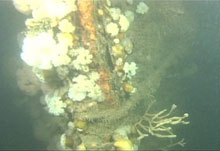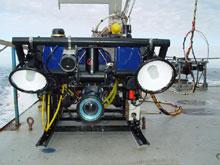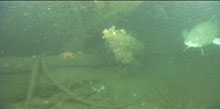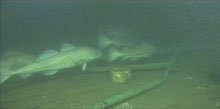
The narrow edge of the Portland’s bow is festooned with marine life, while a rope, possibly from fishing gear, is stretched around that part of the ship. Photo courtesy NOAA/NURC-UConn/The Science Channel. Click image for larger view.
Revisiting the Wreck
Sept. 15, 2003
Ben Cowie-Haskell
Operations Coordinator
Stellwagen Bank National Marine Sanctuary
Principal Investigator, Portland Expedition
We made it down to the wreck today for a 5-hr stay, revisiting some features that we got only tantalizing glimpses of last year, and observing new areas through the “eyes” of a high- definition television camera. Joining us is a team from the Science Channel, part of Discovery Communications, which is preparing a one-hour special due to air in early 2004.
Our day started early, with a 6 a.m. departure from Gloucester, MA. The technical crew had worked into the night to prepare the equipment and tracking software, and we were eager to put the technology to work at the wreck site.

Hela, an ROV carrying a high-definition TV camera (foreground) and Isis, a towed sled with auxiliary lighting, sit on the stern of the R/V Connecticut. Photo by Anne Smrcina, Stellwagen National Marine Sanctuary. Click image for larger view.
At 10 a.m. the ROV (remotely operated vehicle) and Isis system was launched off the back deck. These two separate vehicles are tethered together 50 ft apart and work in tandem. The Isis is supposed to provide the background lighting for the ROV and augment the ROV’s two high-intensity 200-watt lights. Unfortunately, the Isis' steering thruster was not working, so the background lighting worked only intermittently.
Nevertheless, we made it to the bottom and set about getting used to how the system operates. The pilot, Craig Bussel, had never operated these two vehicles in tandem. Using the forward-looking sonar, Craig inched the ROV north toward the wreck. The trick was keeping the ROV and Isis moving in unison, which meant coordinating the ship’s movement (this dictated Isis’ position) with the ROV’s movement. The dynamic positioning system on the ship enabled very precise incremental movements.

As the ROV passed along the fluke of one of the Portland’s anchors, a curious cod kept a watchful eye on the action. Photo courtesy NOAA/NURC-UConn/The Science Channel. Click image for larger view.
The first telltale sign that we were on the right track was coming across an anchor chain. We followed this right to the base of the ship’s bow, where an anchor lay with one of its flukes sticking upright. Near this anchor was a footrope of a trawl net with chafing gear. We panned up with the high- definition camera and there was the base of the plumb bow -- intact and stout as can be! Craig followed the bow up and up to the top. A garden of carnation-like anemones greeted us at the top of the bow stem.
Craig cautiously maneuvered the ROV along the portside toward the stern. Along the way we came across a set of bits, some copper piping, the forward chain locker, which appears to have a winch in it, the beginning of the paddle guard sponson, and large pollock and cod swimming amongst the wreckage.

Schooling cod pass over an area that contains bent steam pipes and what appears to be a stoneware cup, possibly from the crew’s mess. Photo courtesy NOAA/NURC-UConn/The Science Channel.Click image for larger view and image credit.
In many places the longitudinal deck planking was intact and in others it was rotted away, revealing the large transverse deck beams. Reaching the second set of bits on the portside was our clue to search inboard for the forward stairwell. Sure enough, Craig found it easily and maneuvered around the edges of the black hole leading down to the dining area below decks. Someday, when we have the right technology, we’d like to take a good look below decks.
Overall, I’m very pleased with the high- definition imagery we obtained today and the new information we learned about this wreck. The bow is intact, which raises the question of how the ship actually hit bottom. The deck is very fragile, suggesting that we need to “walk lightly” and avoid touching the wreck. Ghost fishing gear presents a real hazard to the ROV, so proceeding cautiously is the name of the game.

















